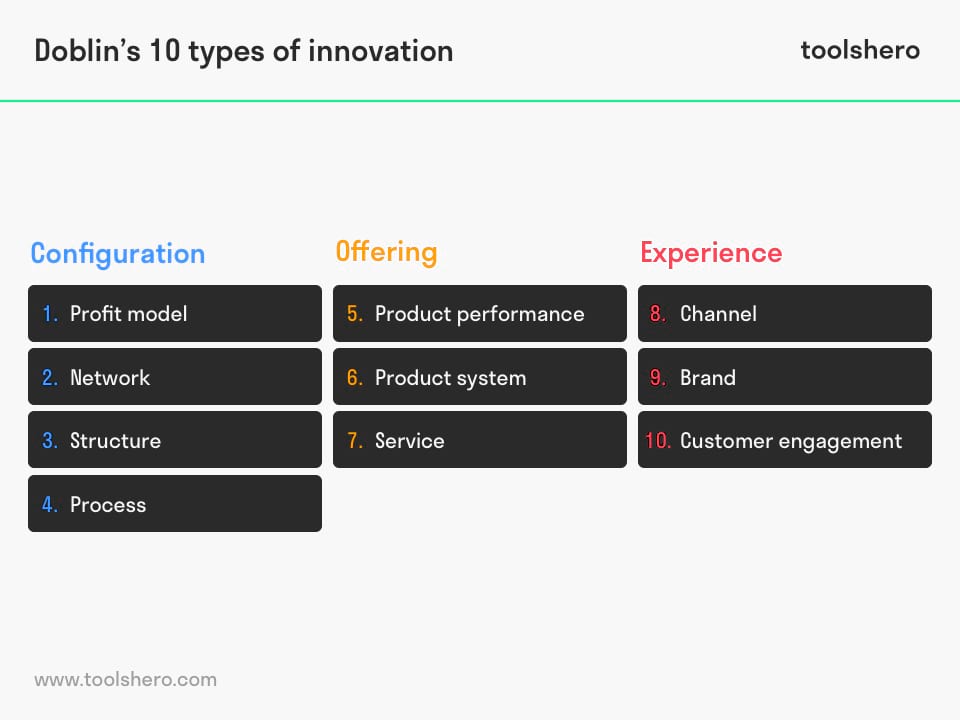Doblin 10 Types of Innovation: a Summary

Doblin 10 Types of Innovation: this article provides a practical explanation of Doblin 10 Types of Innovation, developed by Larry Keeley and Ryan Pikkel. In addition to what the framework is, this article also highlights the importance of innovation. After reading you will understand the basics of this innovation framework. Enjoy reading!
What are the Doblin’s 10 Types of Innovation?
Doblin 10 Types of Innovation is a framework that can be used to identify elements in business that can be innovated to remain or become competitive in the business industry. It is created by Larry Keeley and Ryan Pikkel after in-depth research into how innovations are derived.
After analyzing many innovative techniques, Larry Keeley and Ryan Pikkel concluded that all innovations comprise various elements that together form an innovation. It is additionally described in Doblin’s 10 Types of Innovation. It means that innovations can be made in many different forms, including business models or even customer engagement. When these are separately evaluated and continually improved, it will positively impact the business.
According to the framework, previous companies focus solely on product innovation but this type of innovation is copied easily. As a result, rival companies evaluate other businesses’ competitive advantages regarding products, and next, copy the innovations. Because of this, Doblin’s 10 Types of Innovation identified 10 types of innovation on which businesses should concentrate to remain or become competitive.
Doblin 10 Types of Innovation can be used to evaluate innovation opportunities that help the business grow sustainably and mastering the discipline of building breakthroughs. It can additionally be used to assess the firm’s performance, and thus, benchmark the business performance with that those of rival companies. It can additionally be used to evaluate the industry. For this reason, effectively integrating the framework is going to help the business develop.
It is essential to mention that the type of innovations may differ per industry, organizational culture, or organizational goals. It is therefore essential to identify the capabilities of the firm, but more importantly, assessing how the firm’s capabilities can be used to create new opportunities or make use of new these.
Doblin 10 Types of Innovation framework
After researching a tremendously amount of innovations, including those of General Motors and IBM, Doblin’s 10 Types of Innovation grouped the results into 3 groups and created the following elements to evaluate innovation opportunities:
#1 Configuration
- Profit Model
- Network innovations
- Structure
- Process
#2 Offering
- Product Performance
- Product System
- Service
#3 Experience
- Channel
- Brand
- Customer Engagement

Figure 1 – doblin 10 types of innovation model
1. Profit model
The profit model is an element of Doblin’s 10 Types of Innovation that is concerned with continually identifying ways to increase the revenues of an organization.
Even if some core activities present the main cash flows, it is still important to evaluate new incrementally innovated profit models. It means that companies should asses what customers value and what they demand so that firms can create innovative initiatives that help increase revenues.
2. Network Innovations
This element is part of the collaboration strategy of a company. According to the Doblin’s 10 Types of Innovation, in today’s business environment, every company is connected. Companies collaborate together for mutual interests which many times include enhancing both businesses.
With regards to network innovations, companies should consider the internal capabilities of the firm to assess if these are capable of making an innovation successful or if partners are required. The benefits of collaborative innovation include but are not limited to sharing risks, quickly obtain unpossessed skills and resources, and obtain the necessary capabilities to make an innovation successful.
3. Structure
The structure is according the Doblin’s 10 Types of Innovation concerned with the asset management of the firm. According to the framework, companies should structure their assets to assess how these can be of more value, including (in)tangible assets.
Examples of such assets can be the company’s departments and brands, licensing agreements, but also building, vehicles, computers, and employees. When these assets are continually assessed in terms of how these, for example, are most efficiently depreciated or how employees can best be trained, it will create additional value to the company.
4. Process
Process innovation is innovations that are concerned with, for example, the techniques of producing or marketing goods or services. Based on the Doblin’s 10 Types of Innovation, processes technologies innovation often focus on improving the effectiveness or efficiency of doing business.
Innovating on this element means that a company could experience significant positive impacts such as for example decreased costs because of more efficient handlings or a better ability to react to changes. Processes technologies innovations are, for this reason, difficult to copy and could be a direct competitive advantage.
5. Product Performance
Product performance is concerned with product- and process innovation. It is many times believed that innovating products and processes will gain sustainable competitive advantages, but more frequently, these innovations are rapidly copied by competitors.
However, it is crucial to assess how to continually innovate products and services because companies need to keep up with the market trend before they lack behind with the competition.
6. Product system
Product system of Doblin’s 10 Types of Innovation comprises merged products and services. The goal of this element of the framework is to evaluate how products and services can be combined.
The underlying thought is that product offerings are connected and will be easier to manage when they are grouped instead of handling those separately.
7. Service
Identifying and implementing innovative service initiatives will help the organization improve its customer base, and thus, also increase the firm’s revenue. Today’s companies attempt to offer better service than its rivals, and as a consequence, the level of service of a business has an enormous impact on its success.
Doblin 10 Types of Innovation identified that it is crucial to always asses innovative service opportunities to improve customer experience. When a customer has experienced a great experience in their purchasing process, the chance of returning back for the same or different product is high. As a result, companies can, in this way, build relationships with loyal customer and improve their customer base.
8. Channel
This element of Doblin’s 10 Types of Innovation is focused on how businesses can connect with their customers. It is for this reason concerned with the visibility of the organization on both online and offline channels. This includes outlets and newspapers but also social media channels, websites, and online advertisements.
It is crucial for any business to continually identify new ways of communicating with its customers, especially in this new digital age. With rapid technological innovations, today’s customers spend much time on technological devices. It is up to today’s organization to identify their online journey and then knowing how to be visible to them.
9. Brand
Brand innovations are according to the framework important to be distinguishable from other brands. The goals of such innovations are to make sure that the companies’ brand is chosen instead of those of competitors.
It is for this reason again essential to understand the customer in order to identify what they value. This way allows the company to integrate customer values in the marketing strategies which will strengthen the brand position in the mind of consumers.
It will help create effective marketing campaigns and promotions, and potential customer will recognize the brand.
10. Customer Engagement
Customer engagement of Doblin’s 10 Types of Innovation is a critical element to evaluate because it concerned with the interaction with (potential) customers via customer service. It is important for companies to find innovative ways to communicate with their customer because, without communication, companies cannot determine how the business is experienced by its consumers.
If a business is able to engage with its customers, it is able to identify which elements of business should be improved so that it matches with the customer values.
The importance of Doblin 10 Types of Innovation
Due to globalization and foreign competition, there is a high pressure on firms to innovate continually. For this reason, there is a current race to innovation, and those who stay behind will not remain competitive in the long run. For a company to become competitive, a business should be creative. Both on an individual and organizational level.
Doblin’s 10 Types of Innovation is a helpful framework that helps to identify elements of the business can be innovated. The framework can help to identify radical and increment innovations, products, and process innovations, architectural and component innovation, and competence- enhancing and destroying innovation.
Now it’s your turn
What do you think? Are you familiar with the explanation of Doblin’s 10 Types of Innovation? Are Doblin’s 10 Types of Innovation used at your work, or are you an entrepreneur and have you used it to innovate your business? Do you have any tips or additional comments?
Share your experience and knowledge in the comments box below.
More information
- Curley, M., & Salmelin, B. (2018). The evolution of innovation. In Open Innovation 2.0 (pp. 39-45). Springer, Cham.
- Georghiou, L., Sachwald, F., Griggs, D., Stafford-Smith, M., Gaffney, O., Rockström, J. & Walters, H. (2010). Business model generation: A handbook for visionaries, game changers, and challengers. Hoboken
- Keeley, L., Walters, H., Pikkel, R., & Quinn, B. (2013). Ten types of innovation: The discipline of building breakthroughs. John Wiley & Sons.
- Varis, M., & Littunen, H. (2010). Types of innovation, sources of information and performance in entrepreneurial SMEs. European Journal of Innovation Management, 13(2), 128-154.
How to cite this article:
Zeeman, A. (2019). Doblin 10 Types of Innovation. Retrieved [insert date] from toolshero: https://www.toolshero.com/innovation/doblins-10-types-of-innovation/
Original publication date: 10/28/2019 | Last update: 04/19/2024
Add a link to this page on your website:
<a href=”https://www.toolshero.com/innovation/doblins-10-types-of-innovation/”>toolshero: Doblin 10 types of innovation</a>










